Related Research Articles

Caliban is the second-largest retrograde irregular satellite of Uranus. It was discovered on 6 September 1997 by Brett J. Gladman, Philip D. Nicholson, Joseph A. Burns, and John J. Kavelaars using the 200-inch Hale telescope together with Sycorax and given the temporary designation S/1997 U 1.

Themisto, also known as Jupiter XVIII, is a small prograde irregular satellite of Jupiter. It was discovered in 1975, subsequently lost, and rediscovered in 2000.

Setebos is one of the outermost retrograde irregular satellites of Uranus. It was discovered on 18 July 1999 by John J. Kavelaars et al. and provisionally designated S/1999 U 1.

Sycorax is the largest retrograde irregular satellite of Uranus. Sycorax was discovered on 6 September 1997 by Brett J. Gladman, Philip D. Nicholson, Joseph A. Burns, and John J. Kavelaars using the 200-inch Hale telescope, together with Caliban, and given the temporary designation S/1997 U 2.

Kiviuq is a prograde irregular satellite of Saturn. It was discovered by J. J. Kavelaars in 2000, and given the temporary designation S/2000 S 5. It was named after Kiviuq, a hero of Inuit mythology.

Ijiraq, or Saturn XXII (22), is a small prograde irregular satellite of Saturn. It was discovered by the team of Brett Gladman, John J. Kavelaars, et al. in 2000, and given the temporary designation S/2000 S 6. It was named in 2003 after the ijiraq, a creature in Inuit mythology.
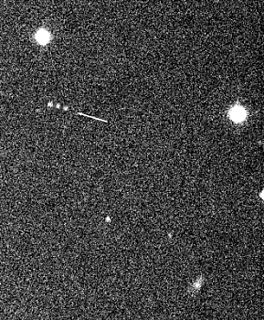
Paaliaq is a prograde irregular satellite of Saturn. It was discovered by J. J. Kavelaars, Brett J. Gladman, Jean-Marc Petit, Hans Scholl, Matthew J. Holman, Brian G. Marsden, Philip D. Nicholson and Joseph A. Burns in early October 2000, and given the temporary designation S/2000 S 2.
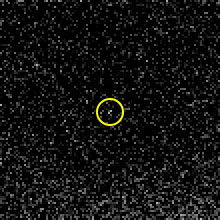
Albiorix is a prograde irregular satellite of Saturn. It was discovered by Holman and colleagues in 2000, and given the temporary designation S/2000 S 11.
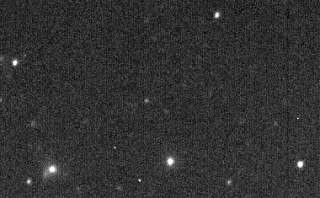
Erriapus, or Saturn XXVIII (28), is a prograde irregular satellite of Saturn. It was discovered by Brett Gladman, John J. Kavelaars and colleagues in 2000, and given the temporary designation S/2000 S 10. It was named Erriapo in August 2003 after Erriapus, a giant in Gaulish mythology; the name was changed from dative Erriapo to nominative Erriapus per IAU conventions in late 2007.
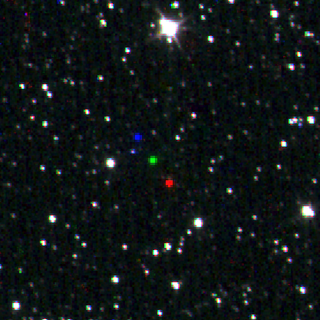
Siarnaq, also designated Saturn XXIX, is a prograde irregular satellite of Saturn. It was discovered at the Mauna Kea Observatory by astronomers Brett Gladman and John Kavelaars in 2000, and given the temporary designation S/2000 S 3. It was named after Siarnaq, more widely known as Sedna, the Inuit goddess of the sea, and is the largest member of Saturn's Inuit group of irregular satellites.
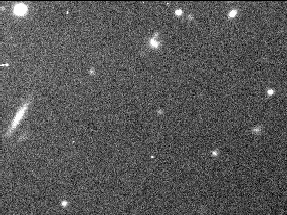
Tarvos, or Saturn XXI, is a prograde irregular satellite of Saturn. It was discovered by John J. Kavelaars et al. on September 23, 2000, and given the temporary designation S/2000 S 4. The name, given in August 2003, is after Tarvos, a deity depicted as a bull god carrying three cranes alongside its back from Gaulish mythology.

Stephano is a retrograde irregular satellite of Uranus. It was discovered by Brett J. Gladman, et al. in 1999, and given the provisional designation S/1999 U 2.
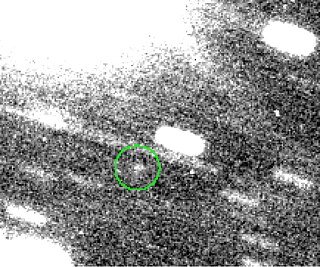
Ferdinand is the outermost retrograde irregular satellite of Uranus. It was first seen near Uranus by Matthew J. Holman, John J. Kavelaars, Dan Milisavljevic, and Brett J. Gladman on August 13, 2001 and reobserved on September 21, 2001. The object was then lost with no confirmation it was actually orbiting around Uranus.

Halimede, or Neptune IX, is a retrograde irregular satellite of Neptune. It was discovered by Matthew J. Holman, John J. Kavelaars, Tommy Grav, Wesley C. Fraser and Dan Milisavljevic on August 14, 2002.
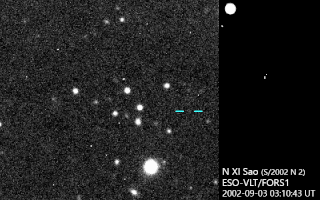
Sao is a prograde irregular satellite of Neptune. It was discovered by Matthew J. Holman et al. on August 14, 2002.
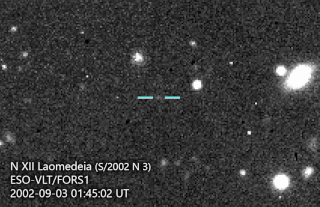
Laomedeia, also known as Neptune XII, is a prograde irregular satellite of Neptune. It was discovered by Matthew J. Holman, et al. on August 13, 2002. Before the announcement of its name on February 3, 2007, it was known as S/2002 N 3.

Neso, also known as Neptune XIII, is the outermost known natural satellite of Neptune. It is an irregular moon discovered by Matthew J. Holman, Brett J. Gladman, et al. on August 14, 2002, though it went unnoticed until 2003. Neso orbits Neptune at a distance of more than 48 Gm, making it the most distant known moon of any planet. At apocenter, the satellite is more than 72 Gm from Neptune. This distance is great enough to exceed Mercury's aphelion, which is approximately 70 Gm from the Sun.
Hans Scholl is a German astronomer, who worked at the Astronomisches Rechen-Institut in Heidelberg, Germany, and at the Côte d'Azur Observatory in Nice, France. In 1999, he was part of a team that discovered three moons of Uranus: Prospero, Setebos and Stephano. He has also co-discoverered 55 minor planets together with Italian astronomer Andrea Boattini at ESO's La Silla Observatory site in northern Chile during 2003–2005.
(44594) 1999 OX3 is an eccentric trans-Neptunian object with a centaur-like orbit from the outer Solar System, approximately 150 kilometers in diameter. It was discovered on 21 July 1999, by astronomers John Kavelaars, Brett Gladman, Matthew Holman and Jean-Marc Petit at Mauna Kea Observatories, Hawaii, United States.
Philip D. Nicholson is an Australian-born professor of astronomy at Cornell University in the Astronomy department specialising in Planetary Sciences. He has been editor-in-chief of the journal Icarus since 1998.
References
- 1 2 3 Schmadel, Lutz D. (2007). "(3666) Holman". Dictionary of Minor Planet Names – (3666) Holman. Springer Berlin Heidelberg. p. 308. doi:10.1007/978-3-540-29925-7_3664. ISBN 978-3-540-00238-3.
- ↑ "About the MPC – Staff". Minor Planet Center. Retrieved 26 October 2016.
- ↑ "MPEC 2021-D60". Minor Planet Electronic Circular. Minor Planet Center. 19 February 2021. Retrieved 22 February 2021.
- ↑ "MPC/MPO/MPS Archive". Minor Planet Center. Retrieved 19 June 2016.
- 1 2 "Minor Planet Discoverers (by number)". Minor Planet Center. 20 August 2016. Retrieved 25 August 2016.
- ↑ "JPL Solar System Dynamics: Planetary Satellite Discovery Circumstances". Jet Propulsion Laboratory . Retrieved 28 October 2016.